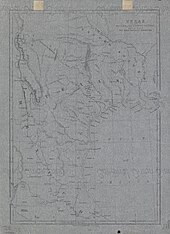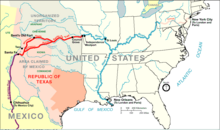Texan Santa Fe Expedition
The Texan Santa Fe Expedition was a commercial and military expedition in 1841 by the
The expedition was a failure. Historian David Lavender called it "one of the most cockeyed ventures in American history."[3] The Texans, approximately 320 in number, surrendered to the superior forces of New Mexican governor Manuel Armijo. The captives were marched 2,000 mi (3,200 km) south to Veracruz, Mexico. They were released in 1842 and made their way back to Texas and the United States.
Journey
The expedition set out from Kenney's Fort in present-day
The journey to New Mexico during the summer was blighted by poor preparation and organization, sporadic Indian attacks, and a lack of supplies and fresh water. After losing their Mexican guide, the group struggled to find its way, with no one knowing how far away Santa Fe actually was. McLeod was eventually forced to split his force and sent out an advance guard to find a route.

The expedition finally arrived in New Mexico in mid-September 1841. Several of their scouts were captured, including Capt. William G. Lewis. Having expected to be welcomed on their arrival, the expedition was surprised to be met by a detachment from the Mexican Army of about 1500 men sent out by the governor of New Mexico, Manuel Armijo. One of Armijo's relatives who spoke English, probably Manuel Chaves or Mariano Chaves, parleyed with the Texans, with Captain Lewis supporting his statements. Both said that Armijo would give the Texans safe conduct and an escort to the border, and Lewis swore to it "on his Masonic faith".[8] After the Texans' arduous journey, they were in no state to fight a force that outnumbered them so heavily, so they surrendered. The New Mexicans gave them some supplies.
However, the following morning, Armijo arrived with his army, had the Texans bound and treated harshly, and demanded the Texans be killed, putting the matter up to a vote of his officers. That night, the prisoners listened to the council debating the idea. By one vote, the council decided to spare the Texans. The latter were forced to march the 2,000 miles from Santa Fe to Mexico City. Over the winter of 1841–42, they were held as prisoners at the Perote Prison in the state of Veracruz, until United States diplomatic efforts secured their release.[9]
After the surviving Texans were released on June 13, 1842, one of the prisoners, Robert D. Phillips, wrote to his father that: "Many of the men are waiting only for the party of a man named Cook to arrive so they may continue on to Vera Cruz and then to New Orleans.[10] The men found their way to New Orleans on board various ships, among them the Henry Clay, which, according to the ship's manifest, arrived in New Orleans on September 5, 1842, carrying 47 "Volunteers of the Texan Army Santa Fe Prisoners."
Role of Native Americans
New Mexico enlisted Puebloans in their effort to repel Texas from expanding its borders in the early 1840s. In 1843 the effort "fell heavily on Taos Indians who were impressed into service to ward off the Texas invaders."[11]
Aftermath

Lewis was widely considered a traitor by the people of Texas, but the options facing the Texans were stark, and standing and fighting would almost certainly have led to their annihilation. Furthermore, there is no information on whether Lewis or Chaves knew Armijo's real intentions. For the rest of his life, Chaves vehemently insisted that he had personally acted in good faith in dealing with the Texans.
Already under serious criticism for his
The annexation changed the ongoing border dispute from being a quarrel between Mexico and Texas to one involving Mexico and the United States. This (combined with controversy over Mexico's treatment of Texan prisoners) helped to increase tensions between the United States and Mexico, leading up to the Mexican–American War.[12] After Armijo surrendered Santa Fe to the U.S. Army without firing a shot, Chaves formally switched allegiance to the U.S.
The war ended in victory for the United States and gave the U.S. undisputed control of all of the lands that at this point were still claimed by the State of Texas. However, Texas faced stiff opposition from within the U.S. in its bid to actually administer these lands. This resistance came largely from
As part of the wider Compromise of 1850 between slave states and free states, the Texan state government agreed to relinquish its northwesternmost territorial claims, including the Santa Fe region that had been the focus of Lamar's expedition. In return, the federal government agreed to assume responsibility for Texan state debts. Texas was left in control of its present boundaries, which was still an area around twice the size of the territory it had ever effectively controlled as a Republic. Most of the remaining lands were organized into the New Mexico Territory while the northernmost strip remained unorganized. Armijo, who returned to New Mexico after the war, died there in 1853.
The final disposition of these regions was not settled prior to the outbreak of the
In popular culture
A Texas Ranger is mentioned as being a "Santa Fe expeditioner" in The Lone Ranch: A Tale of the Staked Plain (1860) by Capt. Thomas Mayne Reid, having "spent over twelve months in Mexican prisons." The expedition also forms the backdrop to Clarence E. Mulford's 1922 novel Bring Me His Ears and to Larry McMurtry’s 1995 novel Dead Man's Walk; also the 1996 TV miniseries - which is part of the Lonesome Dove series.
References
- ^ "Santa Fe Expedition". Lone Star Junction. 1998. Retrieved 2008-08-09.
- ^ Kendall, George Wilkins (1846). Narrative of the Texan Santa Fe Expedition: Comprising a Tour Through Texas and Capture of the Texans. London: Sherwood, Gilbert, and Piper. Retrieved 2007-07-08.
- ^ Lavender, David (1954). Bent's Fort. Garden City, New York: Doubleday & Co. p. 199.
- ^ "Santa Fe National Historic Trail Map" (PDF). National Park Service. Retrieved 2008-07-20.
- ^ "TSHA | McLeod, Hugh". www.tshaonline.org. Retrieved 1 January 2023.
- ^ Kendall, Geo Wilkins (1844). Narrative of the Texan Santa Fé expedition: comprising a description of a tour through Texas, and across the great southwestern prairies, the Camanche and Caygüa hunting-grounds, with an account of the sufferings from want of food, losses from hostile indians, and final capture of the Texans, and their march, as prisoners, to the city of Mexico ; with illustrations and a map. Harper and Brothers. Retrieved 1 January 2023.
- ISBN 9781258028725. Retrieved 1 January 2023.
- ISBN 978-0-8040-0633-0.
- ^ Seymour V. Connor, "PEROTE PRISON," Handbook of Texas Online (http://www.tshaonline.org/handbook/online/articles/jjp02), accessed February 22, 2015. Uploaded on June 15, 2010. Published by the Texas State Historical Association.
- ^ Phillips, Robert D. (1842–1844). Phillips Family Texan Santa Fe Expedition Letters and Documents. University of Texas Arlington Library: Unpublished.
- ISBN 978-0-86534-786-1.
- ^ Texan Santa Fe Expedition at Lone Star Junction website
External links
- Texas and part of Mexico & the United States : showing the route of the first Santa Fé expedition / drawn & engd. by W. Kemble., published 1850, hosted by the Portal to Texas History.
- Texan Santa Fe Expedition
- Online Handbook of Texas
- Thomas Falconer's account from the Sons of Dewitt Colony Texas, accessed June 30, 2006
- Chapters 13–16 of George Kendall's Narrative of the Texan Santa Fe Expedition from the Sons of Dewitt Colony Texas, accessed June 30, 2006
- Phillips Texan Santa Fe Expedition Letters and Documents
- "The Santa Fe Expedition’s Impact on Texas Annexation"


